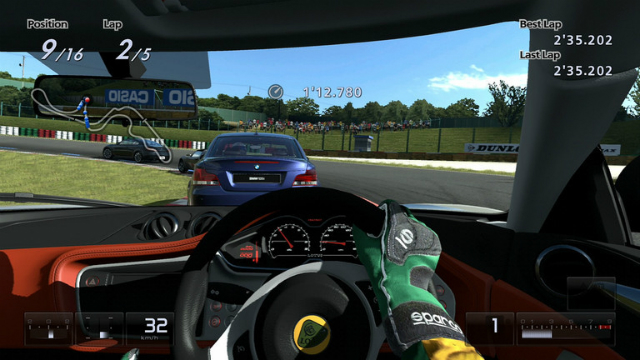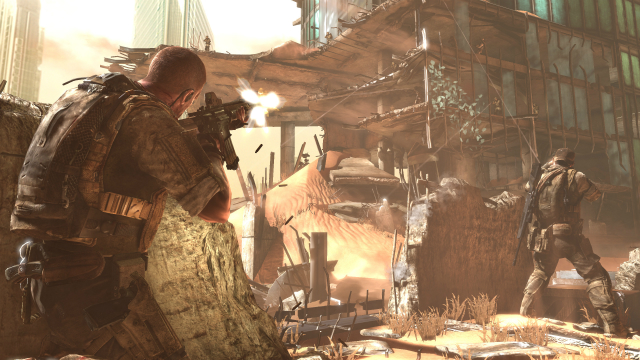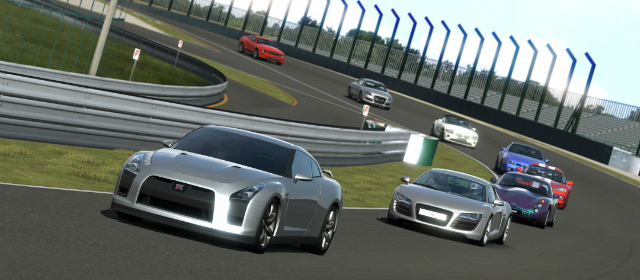Sometime ago in the dim and distant past I wrote a review of Gran Turismo 5 which, by my low-key standards, caused a bit of a furore. I scored the game a seven, which I felt it deserved, but I slightly confused the issue by saying something along the lines of “it has the best driving engine in the universe”. That sort of line doesn’t really jibe with the number seven.
I understand why people were annoyed.
It was poor writing on my part. Polyphony’s game did have standout qualities, but what I failed to communicate was how I found it to be only exciting and immersive in brief moments. That, to me, is the hallmark of a game that isn’t great. Great games grab you and never let you go. The main reason that Gran Turismo 5 didn’t grab me was a design decision (you could argue design philosophy) which had been present since the very first game in the series: A huge percentage of processing power diverted into the visuals, the upshot being limited and uninspiring opponent A.I. Races in driving games, like games of FIFA or bouts of Street Fighter, in some sense produce stories. These stories are called implicit or emergent narrative, born from interactions of a game’s systems which the player experiences as a story. This could be a story about a great Ryu comeback against Ken, the story of a nip and tuck draw between Barcelona (home shirt) and Barcelona (away strip) or the story of a fast race through the field in Gran Turismo 5. The trouble with GT5 was that those stories were never that exciting; cars rarely defended corners, once in a blue moon would an opponent attempt a pass and any wheel to wheel racing was always instigated by the player. The trouble with boring stories is pretty obvious.

The processing power of PlayStation 3 made Gran Turismo 5 look terrific. In fact, for three console generations the Gran Turismo series had looked great. However, not enough of the processor was devoted to creating magic moments. These moments, the “stories” of Gran Turismo 5, were largely non-existent, and it made the game immediately less immersive and less memorable over time.
My hope for the inevitable sixth game in the series is that Polyphony take the new power available in PlayStation 4 and push more and more of it into the opponent A.I. I want races which I tell my friends about, which I remember for years, and where I feel a real struggle. I want races with stories. If all I’m left with is another “battle” against a procession of cars then, for me, the game will not be enjoyable. A great digital museum, yes. A great game, no.
At this point I feel as if I should stop sticking the boot into Gran Turismo. The seven out of ten was ignominy enough. What an awful man I am.
The real purpose of this column is to say that I’m excited to see what developers can do with the power of the next console generation. Not just for Polyphony, but what opportunities for story does any developer have now and in the future. It was my previous column, where I talked with Mick Fraser about Bungie’s storytelling aspirations in Destiny, which got me thinking about this. Where is it all going? What’s next for story in games? As graphics continue to increase in quality, there will be a diminishing return on investment in that area. Could the same be said for story? Or are we not there yet, and does great investment still have the potential to yield great return?

Another way of looking at it could be to say how much difference does processing power and money make to a better story? A huge processor doesn’t guarantee an interesting story, certainly, but there are areas where power helps. More disc storage space could have allowed more content, more choices and divergent outcomes, in Mass Effect 3 for example. Heavy Rain might well have been even more compelling with improved facial detail and animations, made possible by a more powerful graphics processor. Certainly more power would have allowed for the virtual actors to emote more convincingly. To argue the opposite, I suppose, would be to argue that storytelling in games hasn’t improved since the days of the Spectrum or Amiga, at least not because of technology. It may be purely a talent thing, where the knowledge and talent of writers and narrative designers is pulling the standard of storytelling in games up and up, whether technology is a help or a hindrance.
Personally I believe that technology does affect storytelling, and will continue to do so. Over the months that I’ve been doing this column one of the thoughts I’ve often had is that, somehow, story isn’t the right word for what designers and writers are doing in games. They are building worlds. Is that truly storytelling, or something else? That isn’t to suggest that Tolkien or Neil Gaiman (or many, many other writers) don’t build worlds when they tell their stories; that would be be a huge disservice to their talents. However, the end result is different. A novel might be more of a tour of a world, shown from the angles that the author lets you see it from. A game is less of a tour and more of a slate of possibilities. The developer can control your viewing angle up to a point, but if cracks are there then players will find them. To take the world builder idea further, think of the far future. What is interesting is thinking of the game writers as architects of worlds, where A.I. governs the interactions which the player experiences with other characters, but this interaction happens within a carefully sculpted framework created by the writers and designers. It is the Gran Turismo example extrapolated out onto adventure games where, rather than moving through a procession of characters with pre-scripted dialogue, we battle with characters who can respond to your actions and, in turn, make the player think on their feet. Then it isn’t really story any more, rather the player will experience the sort of emergent narrative which games like FIFA provide at the moment. Only now it could be in a sci-fi, historical, or political setting, rather than on a sports field or a race track.

I’m aware that for the second consecutive column I’m wandering into a fantasy world. Last week it was speculation, this week I’m looking into a crystal ball.
In reality, we are a few years away from what I’m describing. Rather, I think the great storytelling opportunity of the new console generation is the download stores, and the variety of the business models the console manufacturers will have to try to stay competitive. I’m hoping for a broader range of price points, so that narrative driven games like Spec Ops: The Line can be released for twenty five pounds or so, without the need to bolt on sub-standard multiplayer modes to justify a mandated £40 price point. I’m hoping that smaller developers and indies get support on the store, through PS Plus or through advertising, so that games like Thirty Flights of Loving can make it to console quickly and be lucrative for developers. It’s important that the new download environments on PS4 and the next Xbox are encouraged to be both a creative hotbead and financial success, because with stories like this one coming out recently it is clear that developers need alternative outlets as Apple tries to assert monopoly power and use it for censorship.
None of this future gazing should serve to cloud the achievements of the last console generation. There are so many games which use story brilliantly and which lifted the quality of video game storytelling. There are yet more to come before the PS4 hits. My hope is that Polyphony, and every other developer, finds ways to squeeze more narrative through the tubes of that flashy RAM and powerful processor, so that the narrative experiences can be truly next gen too.





